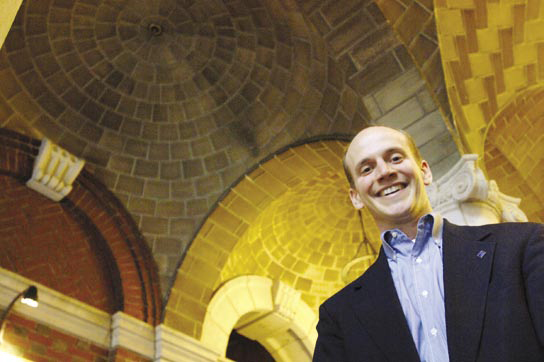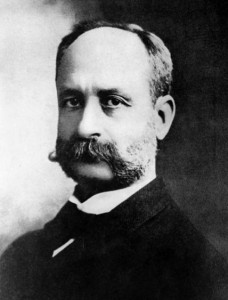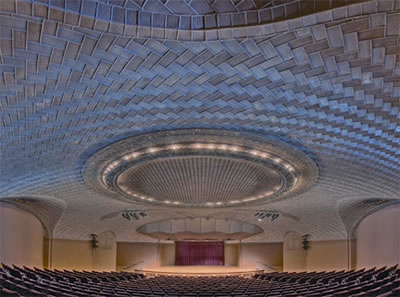The amazing ceiling of Baird Auditorium
When you attend your next event at the Natural History Museum’s Baird Auditorium—and we hope it will be Saturday, June 18 at 11:00 a.m. for a lecture and book-signing by John Ochsendorf—feast your eyes on the exquisite tiled ceiling above you. The ceiling is constructed using a technique devised by the Spanish Guastavino family that became one of the most widely used decorative building methods in the United States during the late 19th and early 20th centuries.
Born in Valencia, Spain, Rafael Guastavino (1842-1908) began his career as an architect. A contemporary of of the Catalan architect Antonin Gaudi, he became interested in a construction technique that had its antecedents in the ancient world and was revived in mid-19th-century Spain. In 1881 Guastavino and his son immigrated to the United States where he introduced thin-tile vaults. Guastavino perfected (and patented) his “timbrel vaulting” technique into one of elegance and grace used by many prominent U.S. architects for the ceilings of large spaces. Architects loved the delicacy of the thin terracotta tiles that gave these ceilings a unique “herringbone” look. The vaulting technique not only encompassed fireproofing but also was economical—a dream for any builder.
Combining beauty, safety and financial acumen, the technique developed by Guastavino was used in over 1,000 buildings throughout the United States, including the Boston Public Library; Grand Central Station and its famed Oyster Bar; the Cathedral of St. John the Divine; the main hall at Ellis Island (amazingly, of the original 28,832 tiles set in 1917 when the ceiling was rebuilt, only 17 tiles were replaced during the restoration in the 1980s); Carnegie Hall; the Nebraska State Capitol, the U.S. Supreme Court; and countless others.
Rafael Guastavino settled near Asheville, N.C., where he died in 1908. His son Rafael III continued to run The Guastavino Fireproof Construction Company, which remained in business until 1962.
John Ochsendorf will reveal everything you have always wanted to know—and then some—about this revolutionary technique in a lecture on June 18 at 11:00 a.m. in Baird Auditorium, the Smithsonian’s own spectacular example of the Guastavino legacy.

John Ochsendorf under a Spanish tile vault on the MIT campus, built in 1901 by Rafael Guastavino. (Photo Credit: Donna Coveney/MIT)
His professorship at Massachusetts Institute of Technology has allowed him to pursue his interest in the Guastavino family. Ochsendorf is the first—and only—engineer to be awarded a prestigious MacArthur Fellowship, and he was a recipient of the Rome Prize, given by the American Academy in Rome. His acclaimed book, Guastavino Vaulting: the Art of Structural Tile imparts the thrill of discovering Guastavino vaults throughout the world, explaining this magical technique and returning the name Guastavino to the forefront of architectural history. As Ochsendorf said in a recent interview in the Boston Globe, “Rafael Guastavino was one of the greatest American architects you’ve never heard of.”
Join us for this free illustrated lecture and meet Ochsendorf after at a book signing. This lecture is open to the public; no registration is required.
Check out a slideshow of some of Guastavino’s most impressive work from the New York Times.
This post was contributed by Amy Ballard, Senior Historic Preservation Specialist: Architectural History and Historic Preservation, Smithsonian Office of Facilities, Engineering & Operations.
Posted: 15 June 2011
- Categories:






Just wanted to let you all know that we had over 250 people at our lecture on 18 June! Thank you for coming!